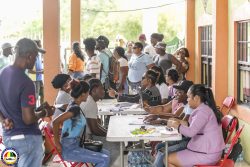Introduction
This column takes a long-term view in analysing the 2012 budget, which is set to see spending of $193 billion in the next fiscal year. In the Development Watch columns it is natural to focus on trends and policies that are transformative – thus making the distinction between short-term stabilisation and long-term growth. Stabilisation measures include efforts such as prudent fiscal and monetary policies. The target of these policies includes maintaining stable prices and exchange rate. Fiscal policy refers to tax and expenditure policies. When we subtract total government expenditures from total revenues we obtain either a fiscal deficit or surplus (the fiscal balance). At the core of fiscal policy is maintaining a sustainable fiscal balance, whether positive or negative. Monetary policy – conducted by the Bank of Guyana – is intricately connected to fiscal policy; however, many economists believe monetary policy should be independent of the Minister of Finance and President of a nation. Guyana’s central bank, the Bank of Guyana, manages the nation’s supply of money and the exchange rate as part of its monetary policy operation.
 Past columns have noted that stabilisation is a necessary but not sufficient condition for long-term economic growth and development. We have a relatively stable economy in terms of the exchange rate, inflation rate and fiscal deficit. These are all important and welcome developments. The real GDP grew at an annual rate of 5.4%. The inflation rate is 3.3% and the fiscal deficit is a respectable 4.4% of GDP. No doubt this reasonable fiscal deficit comes from the introduction of the VAT that brought in more than expected revenues. In the past, I have argued that this unexpected increase in VAT revenues comes mainly from the large underground economy. While those operating in the underground economy can evade income taxes they still need to consume; therefore they pay the VAT, a consumption-based tax. The economy appears to be moving along a stable path. However, the long-term economic growth and development are far from certain given the numerous challenges Guyana faces and which the PPP government of nineteen years has not even started to address.
Past columns have noted that stabilisation is a necessary but not sufficient condition for long-term economic growth and development. We have a relatively stable economy in terms of the exchange rate, inflation rate and fiscal deficit. These are all important and welcome developments. The real GDP grew at an annual rate of 5.4%. The inflation rate is 3.3% and the fiscal deficit is a respectable 4.4% of GDP. No doubt this reasonable fiscal deficit comes from the introduction of the VAT that brought in more than expected revenues. In the past, I have argued that this unexpected increase in VAT revenues comes mainly from the large underground economy. While those operating in the underground economy can evade income taxes they still need to consume; therefore they pay the VAT, a consumption-based tax. The economy appears to be moving along a stable path. However, the long-term economic growth and development are far from certain given the numerous challenges Guyana faces and which the PPP government of nineteen years has not even started to address.
A Closer Look at the GDP Growth Rate
Although it appears relatively good compared with Caribbean economies, the 5.4% growth in 2011 hides several unpleasant facts. The first thing to note is it reflects a 7.1% increase in sugar production which is coming from a previous year of contraction. In other words, the economy is merely regaining lost ground. This is not growth from a new production sector or the attainment of an unprecedented level. The same thing can be said about the rice sector. The mining and quarrying sectors realised an impressive growth rate of 19.2%. However, I would not pin my long-term hopes on exporting unprocessed gold bars. The price of gold has to decline as the US economy gains strength, the Federal Reserve increases the benchmark interest rate and the US dollar starts to appreciate.
Of course, the problems coming out from the Skeldon sugar factory will take millions of US dollars to fix, thus taking away scarce resources from other sectors of the economy – the price of bad policies and a dubious contract awarding system. The same can be said for the Amaila hydroelectric project access road – Fip’s road. No new entity akin to Banks DIH or DDL was created in nineteen years. Omai Gold mines came and went. Manufacturing and industrial corporations like Banks DIH and DDL are legendary staples in Guyana. Banks DIH even built houses for its employees, something which I doubt thin retail margin shopping malls and primary resource extractive industries can do. We need them all, but the PPP government just never got the mix right in nineteen years.
Physical and Intellectual Infrastructure
For long-term growth physical infrastructure – roads, bridges, wharfs, etc – are critical. The capital expenditure of the budget covers these things. The budget is expected to spend about 40% on capital projects. Questions remain, however, whether the government is receiving value for money given how quickly some of the infrastructure projects are disintegrating. Another issue is the sequencing of infrastructure projects. Many Guyanese, I believe, will say solving the perpetual flooding problems is more important than building a US$170M airport terminal. Resources are limited. At some point the airport project will take away funds from drainage projects.
It is well known that education, and research and development are crucial for maintaining long-term production growth in an economy. Hence tertiary education is an essential component in any development strategy. The government continues its $900 million funds to UG. In addition, the government is negotiating a US$10 million loan to upgrade the scientific research facilities at UG, obviously a welcome development. In this regard, $80 million goes for curriculum enhancement. An external consultant will be paid to oversee governance at the university. This effort will not result to anything substantial. The University of Guyana can only thrive when embedded academics – and not those also connected to GINA or external consultants – take command of governance and curriculum development. This is how universities are run in North America and the United Kingdom. Expect more of the same.
Public Debt
The external debt stands at US$1.2 billion, while the domestic debt is US$728 million. These are clearly large numbers, but years of debt relief and refinancing has helped to reduce the debt service payments to a manageable level. This situation can change if the US$58 million Marriott project, the US$178 million airport project and the US$900 million Amaila project come on stream. The financing terms on these debts are not going to be as concessional as the existing stock. Debt service payments will jump overnight and we can expect a rising fiscal burden.
In the past, the Development Watch column commented on all three projects. I think the Marriott should only be done with private funds and no government funds should go to financing a hotel when present hotels are not seeing capacity occupancy. The airport terminal is just bad sequencing at this point in Guyana’s history, and there are other renewable energy options relative to Amaila such as smaller hydroelectric projects and bagasse electricity integrated into a smart grid system.
Conclusion
The government has to rethink the renewable energy policy under the LCDS. The REDD+ system, which is now at the heart of its financing, is not going to realize any major funds for development finance. The will is just not there globally for these kinds of systems. The sustainability of the NIS is a serious long-term problem facing the nation. The budget does not even begin to address this problem. But to be fair to the Minister of Finance, solving NIS’s problems are beyond a regular budget exercise. Several of the Jagdeo era proposals like the one lap top, LCDS, the Marriott hotel, the airport project and others are brought forward into the Ramotar government. It might take President Ramotar acting more like Lula instead of Medvedev to make sure these projects do not jeopardize the favourable fiscal and exchange rate positions he inherited.
Please address comments to: tarronkhemraj@gmail.com









